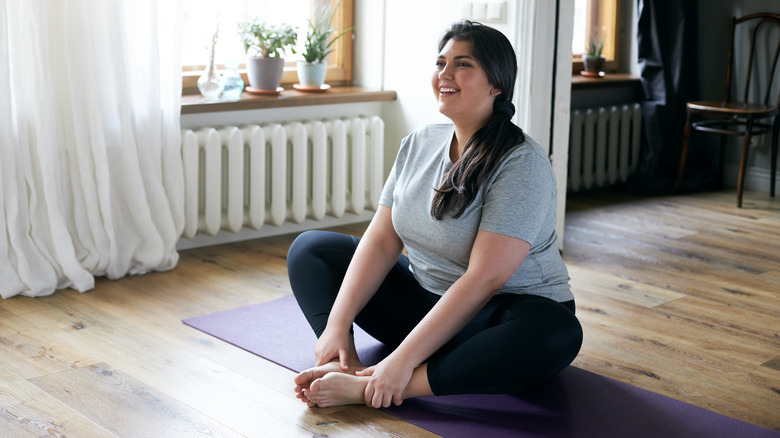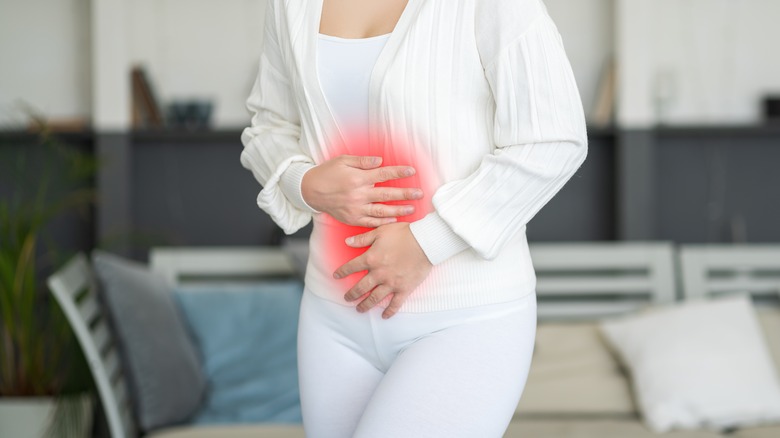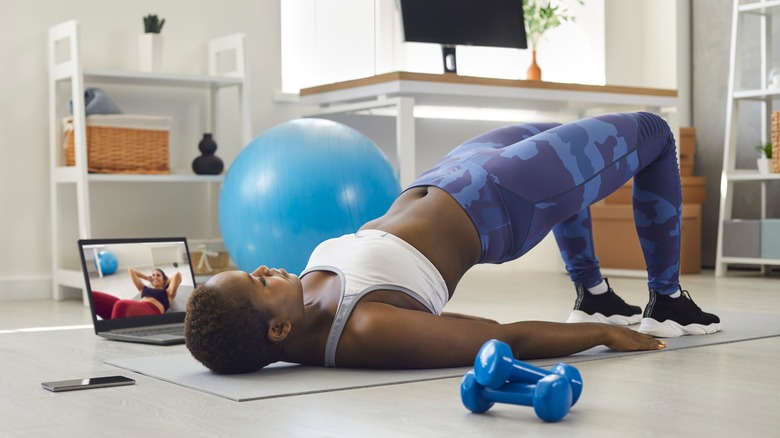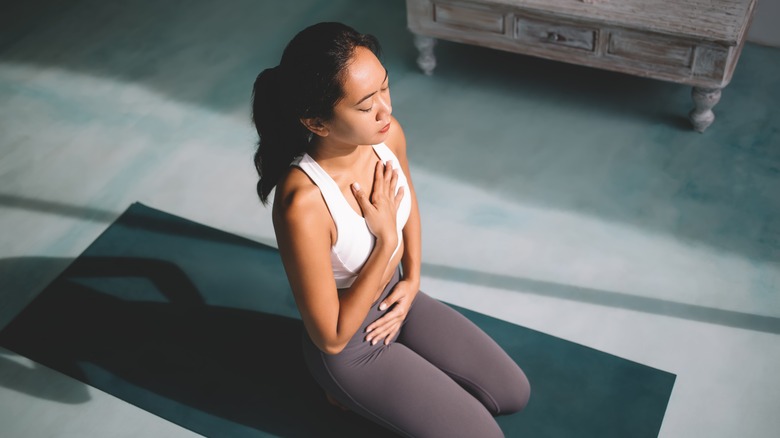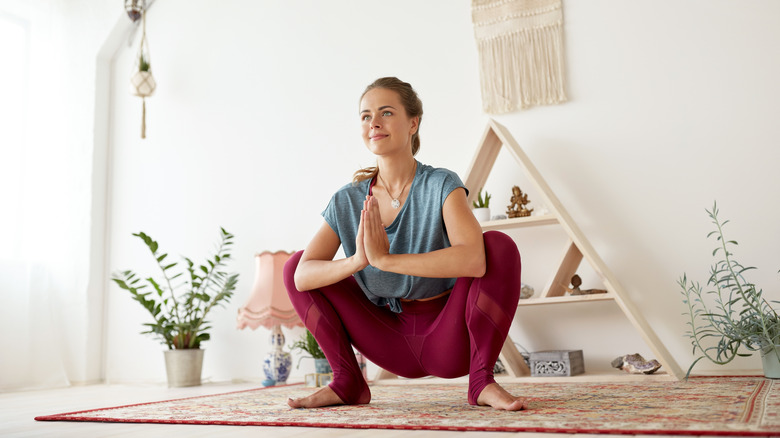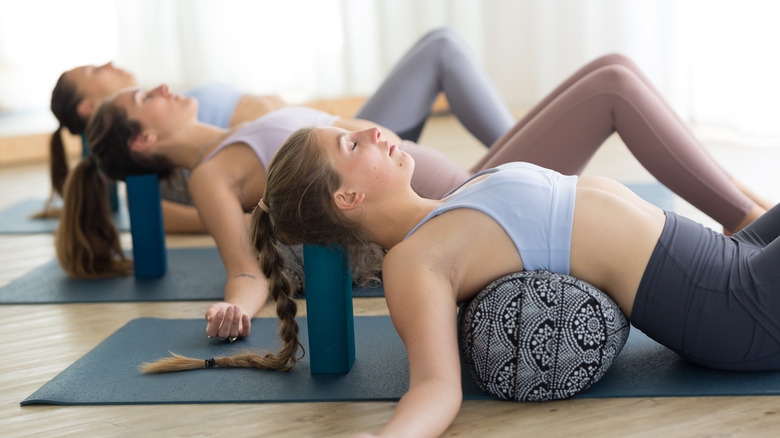How Yoga Can Help Reduce Endometriosis Pain
Today, people around the world use yoga to tone up, reduce stress, and improve their well-being. Research shows that yoga may relieve some of the symptoms of various pain-related conditions, such as migraine, fibromyalgia, arthritis, and back pain (via Indian Journal of Palliative Care). The ancient practice has also been found to help people cope with endometriosis, according to a study from The Journal of Alternative and Complementary Medicine.
Endometriosis affects around 10% of women of reproductive age globally, reports the World Health Organization. It has a number of unpleasant symptoms including pelvic pain, which tends to be most severe during menstruation. The gynecological condition can also make it harder for women to get pregnant. With early and appropriate treatment, however, many of the issues caused by endometriosis can be improved or minimized.
Read on to find out how yoga can help ease the everyday aches and pains of endometriosis.
What is endometriosis?
Endometriosis is a painful disorder where endometrial-like tissue grows outside of the uterus, explains the World Health Organization. When a woman has her period, this tissue gets trapped inside the body, according to Mayo Clinic. Surrounding tissue can become irritated and cysts may develop in the ovaries. Pain usually occurs around the pelvic area, especially during menstruation. Other common symptoms include lower back and abdominal pain, excessive bleeding during periods, pain during or after sex, abdominal bloating and nausea, and fatigue.
The symptoms of endometriosis can range from mild to severe (via World Health Organization), and some people have no symptoms at all. The level of pain a person experiences isn't a reliable indicator of the extent of their condition. It's possible to have mild endometriosis with intense pain, or advanced endometriosis with little to no pain.
Endometriosis affects various parts of the body, including the immune system, digestive tract, and hormones, notes the Endometriosis Association. It's not sexually transmitted and can affect people who aren't yet sexually active. It can be a puzzling disease, and as of yet, there's no cure.
How can yoga help with endometriosis?
Yoga can help improve or alleviate some of the unpleasant symptoms of endometriosis, including stress, tension, and pelvic pain. A study published in the International Journal of Yoga found that after eight weeks, participants who received yoga therapy experienced a significant reduction in the intensity of pelvic pain. The women also saw improvements in other areas of their lives, including physical, psychological, social, and environmental domains.
Regular yoga practice has been shown to decrease chronic pelvic pain in women who have been diagnosed with endometriosis. For example, a study from the Journal of Alternative and Complementary Medicine examined women with endometriosis who attended two yoga classes per week for two months. Based on the findings, the yoga classes helped the women manage their pelvic pain more effectively by building a strong mind-body connection. The women also reported that the breathing techniques (pranayama) improved their introspective ability, which helped relieve pain.
The effects of yoga on the body
Yoga affects various aspects of a person, ranging from the physical and intellectual to the emotional and spiritual, according to researchers (via Indian Journal of Palliative Care). Yoga allows the body and mind to energize, relax, and rejuvenate, which, in turn, can have a positive effect on pain relief. The poses and breathing techniques help to re-balance the physiological system and trigger a "relaxation response" in the body. This results in calmer breathing patterns, lower heart rate, less muscle tension, and a more stable blood pressure.
Yoga can help in other ways too, per the Indian Journal of Palliative Care. For instance, with regular practice, yoga promotes deeper and more efficient sleep. Various yoga poses help improve posture and strengthen the body. These physical changes can help individuals better manage pain and fatigue. Meditation and breathwork (pranayama) along with gentle, restful poses can also help people tackle some of the emotional aspects of chronic pain such as anxiety and stress.
Which yoga poses can help?
So which yoga poses in particular can help make the pain caused by endometriosis more manageable?
The butterfly, known in Sanskrit as Baddha Konasana, is a relieving posture for people who suffer from painful groins and hips. According to a 2017 study published in the journal Pain Medicine, women who participated in a yoga class consisting of 12 postures including the butterfly, experienced substantial improvements in pelvic pain, sexual function, and general emotional well-being. This classic seated pose is supposed to look a bit like a butterfly in motion (via Healthline).
The garland pose, also known as Malasana, is a deep squat that helps open up the hips and groin and increases flexibility and circulation in these parts of the body (via EkhartYoga). It's said to work wonders in alleviating endometriosis pain and menstrual cramps. To modify the pose, you can place a rolled-up blanket under the heels or lean against a wall.
The happy baby, also known to yogis as Ananda Balasana, is another hip opener that was incorporated into the therapeutic yoga program described in Pain Medicine. It encourages the pelvic floor muscles and hips to let go of tension, notes Healthline. Other yoga poses recommended by Healthline include the restorative goddess pose, supine spinal twist, child's pose, legs-up-the-wall pose, reclined hero pose, and reclined bound angle pose.
The risks of practicing yoga with endometriosis
The pain-relieving benefits of yoga are widely known, so it may surprise you that some poses can actually make your pelvic pain worse (via EkhartYoga). This tends to be the case with more vigorous styles of yoga, like ashtanga or power yoga. Poses that fall into these categories can trigger flare-ups, especially in women who are menstruating. Quieter styles of practice like yin, restorative, or hatha yoga are more suitable for people with endometriosis.
Needless to say, it's important that you listen to your body and steer clear of any poses that worsen or aggravate your symptoms. Be sure to take enough time to heal and consult your surgeon before practicing if you've recently had abdominal surgery, notes Healthline.
Given its effectiveness in reducing chronic pelvic pain, yoga is widely touted as suitable for people with endometriosis. Practitioners continue to recommend yoga for its powerful pain-relieving benefits and the science seems to agree (via The Journal of Alternative and Complementary Medicine).

